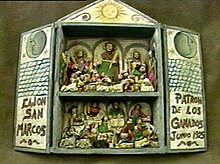
Back Retablo AN حاجز خلفي Arabic Retablu AST Retaule Catalan Retabulum Czech Altarretabel German Ντοσάλε Greek Retable English Retablo Esperanto Retaabel Estonian







El retablo es la estructura arquitectónica, pictórica y escultórica que se sitúa detrás del altar en las iglesias católicas de rito latino; en las iglesias orientales en comunión con Roma o no, anglicana o luterana no hay una función semejante, dada la presencia del iconostasio, y en las protestantes suele optarse por una gran reducción de la decoración.
La palabra deriva de la expresión latina retaulus, que viene de retro (lit., 'detrás') tabula (tabla).[2] que significa "figuras que se ponen sobre una tabla para contar una historia".
También significa tabla detrás de un altar. Para designar el mismo término se emplea también la expresión "pieza de altar" (más propia de la lengua inglesa –altarpiece–, donde se distingue retable de reredos)[3] o la italiana pala d'altare (o ancóna).[4].
- ↑ Templo de Santa Rosa de Lima en Morelia.
- ↑ Según el DRAE: Del b. lat. retaulus, y este del lat. retro, detrás, y tabŭla, tabla. Las fuentes discrepan sobre la identificación de tal "tabla" con las del propio retablo o con la mesa del altar: The Spanish word retablo was derived from the Latin term retro tabula for "behind the altar" (retro for back and tabula for board, tablet; the Latin tabulum means table) (Art and Faith in Mexico: The Nineteenth Century Retablo Tradition). From the low Latin retaulus (retro-tabula), something "behind the table" or altar. (The Art and Architecture of the Texas Missions - Página 218). Deriva del latín vulgar, retaulus (Latín: retro tabula, literalmente, detrás de la mesa) (Los retablos del siglo XVIII en el sur de España, Portugal y México - Página 15). ...se pone este tablero atrás del altar, de ahí su nombre: retro tábula (Manual de arte cristiano... - Página 317)
- ↑ En lengua inglesa se establece una diferencia entre dos tipologías de altarpieces, la denominada reredos y la denominada retable. Nicolas Pioch, Webmuseum, 14 Oct 2002: Altarpieces divide into two main types: the reredos, which rises from ground level behind the altar, and the retable, which stands either on the back of the altar itself or on a pedestal behind it. Many altars have both.
- La etimología de "reredos" proviene del anglo-normando o del francés antiguo areredos, y este de arere (detrás -del latín ad retro-) y dos (espalda -del latín dorsum-). Dictionary of the English Language, 2000, Houghton Mifflin Company; Collins English Dictionary, HarperCollins Publishers, 1991 (The free dictionary).
- The foreign "retable" is, therefore, what should in English be called a "reredos" (q.v.), though that is not in modern usage a movable feature. Encyclopedia Britannica, 1911
- REREDOS (Anglo-Fr. areredos, from arere, behind, and dos, back), an ornamental screen of stone or wood built up, or forming a facing to the wall behind an altar in a church. Reredoses are frequently decorated with representations of the Passion, niches containing statues of saints, and the like. In England these were for the most part destroyed at the Reformation or by the Puritans later; a few medieval examples, however, survive, e.g. at Christchurch, Hants. In some large cathedrals e.g. Winchester, Durham, St Albans, the reredos is a mass of splendid tabernacle work, reaching nearly to the groining. In small churches the reredos is usually replaced by a hanging or parament behind the altar, known as a dossal or dorsal. (See also Altar.) For the legality of images on reredoses in the Church of England, see Image. The use of the word reredos for the iron or brick back of an open fire-place is all but obsolete. Encyclopedia Britannica, 1911
- ↑ *Giovanni Gheradini Voci e maniere di dire italiane additate a'futuri vocabolaristi, Bianchi e comp., 1838, vol. 1, pg. 646: ANCÓNA. Sust. f. Tavola dipinta, quadro... deriva dil greco Eicon... [es decir, de εἰκών -eikon, Imagen, icono-]... Alberti, il qual dice qui per "Ancona" si intende "Tavola o Quadro grande di altare". Ma, oltreche gli artisti in tal signif. speciale usano la voce "Pala"...
- Architettura, 1963, pg. 117: ... al gotico, che adotta quindi la Pala o Ancóna, sotto la partitura del trittico e più frequentemente del polittico.
© MMXXIII Rich X Search. We shall prevail. All rights reserved. Rich X Search